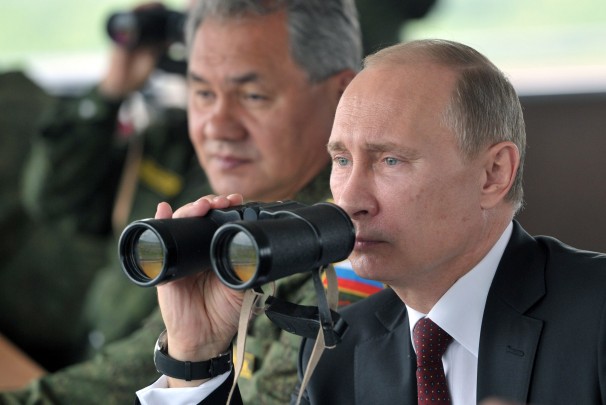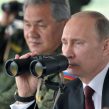
Russia’s Military Response to the Asia Pivot: Flexing Small Muscles
Publication: Eurasia Daily Monitor Volume: 10 Issue: 135
By:

On July 12, during a meeting between President Vladimir Putin and Defense Minister Army-General Sergei Shoigu, Russia’s commander-in-chief ordered a “surprise inspection” of combat forces in the country’s Far East. In the early hours of July 13, according to the defense ministry website, a “snap military exercise” commenced, described as the largest military exercise in post-Soviet history (www.mil.ru, July 13). The scale of the exercise, the units involved, proximity to China and Japan, media coverage, and numerous other features marked out this exercise as unique, though there are grounds to question its status as a “snap inspection.”
In February 2013, Putin ordered the first of these “snap inspections” in order to regularly test combat readiness within individual Military Districts (MDs). And since then, such inspections have involved around 7,000–9,000 troops. The concept is to prepare an unannounced inspection of military units, with orders from the General Staff provided to brigade headquarters without advanced warning. The pattern to date has been to bring units involved in such inspections to a level of combat readiness, have them respond to an alert, and then move to a designated assembly point. The latest exercise staged in East MD with supporting units deployed from Central MD differed in both scale and the actual reported use of exercise scenarios (RIA Novosti, July 14).
According to the Russian defense ministry, at 0100 hours on July 13, the commander of East MD, Admiral Konstantin Sidenko, opened a secret file from the General Staff containing tasking for his forces. An official defense ministry report described the scale of the exercise: “A total of more than 80,000 troops, some 1,000 tanks and armored fighting vehicles, 130 aircraft and helicopters from the Long-Range, Military-Transport, Fighter, Bomber and Army Aviation, as well as 70 combatant and auxiliary ships of the Russian Navy, are involved in the combat readiness check,” adding that the it was scheduled to end on July 20 (www.mil.ru, July 13). Rossiya 24 provided regular hourly updates, and by 0800 on the same day reported that all units in East MD had reached “combat readiness state 1” (Rossiya 24, July 13).
By July 16, however, the defense ministry press service reported that up to 160,000 troops were involved in the exercise, as the media focus shifted to the arrival of President Putin at an observation tower on Sakhalin to witness one of the exercise scenarios. Putin was accompanied by Shoigu and the Chief of the General Staff Army-General Valeriy Gerasimov. The scale of the exercise extended to all combined formations in East MD, some drawn from Central MD, Long-Range and Military Transport Aviation and naval units. The inspection was officially aimed at assessing the competence of personnel, technical readiness, equipment levels and the strategic mobility of units deploying over distances of up to 3,000 kilometers. The defense ministry later issued a revised statement on its scale: “The total strength of the troops that are involved in the combat readiness inspection is more than 160,000 servicemen” (www.mil.ru, July 16).
Gerasimov reported to Shoigu during a teleconference on July 13 “full combat readiness” was achieved in the following units: “The 5th, 29th, 35th and 36th Armies of the East MD, the Pacific Fleet, the 3rd Air Force and Air Defense Command, the formations subordinated to the MD, the 18th Machine Gun and Artillery Division (stationed in the Southern Kuriles), the 39th Motorized Rifle Brigade (MRB), the 83rd Airborne Assault Brigade, the 3rd Logistical Support Brigade, the Military Transport Aviation air bases and the 1st Mobile Nuclear, Biological and Chemical Defense Brigade.” The 64th MRB deployed to Uspenovskiy military range on Sakhalin Island by rail, sea and air, to check its combat readiness. The 5th Tank Brigade and 75th Command and Control Brigade of the 36th Army redeployed some of their forces by rail and under their own power to Tsugol military range (Interfax, July 13). Gerasimov made no reference to units from other power ministries.
One clear “test” during the exercises related to strategic mobility. Much media attention was devoted to the use of Military Transport Aviation, but the number of flights involved as well as sorties to return forces to base suggests that troop movements depended heavily upon rail infrastructure. Using transport aviation to move troops and equipment was marred by a lack of coordination between the East MD HQ and the administration of civilian airfields; delays over payments resulted in the departure of transport aircraft being held up for as much as ten hours (Channel One TV, July 13). The combat support system was tested, issuing 142 tons of munitions and 24 tons of fuel, setting up 20 field mass refueling facilities. Significantly, outsourcing companies, responsible for service to troops in peacetime, were replaced by the combined-arms brigades logistics support subunits and by MD logistics support brigades operating in field conditions (www.mil.ru, July 17).
The exercise scenarios focused on combined-arms operations in the Russian Far East, environmental disaster relief and on rehearsing a defense of the Kurile Islands against a joint attack by the United States and Japan. On July 17, Long Range aviation carried out four sorties along Russia’s borders, while the defense ministry noted this included “internal territories of the Sea of Japan and the Sea of Okhotsk, neutral waters of the Pacific Ocean north of the Japanese islands.” Three Tu-95MS bombers conducted flights to test air defense systems in East MD’s 3rd Air Force and Air Defense Command around Sakhalin and the Sea of Japan. These air assets are adapted for surveillance missions (Interfax July 13–17; RIA Novosti, July 17).
Nevertheless, the scale of the exercise, preparation of the logistical and transportation support, cancellation of leave for military personnel and the testing of strategic mobility all indicate that considerable planning went into this exercise; it is unlikely that was in fact a real “snap inspection.” It was politically calculated to show Russia’s neighbors in the Asia-Pacific that Moscow has the political will to defend far flung territory during a crisis. Equally, it sends a signal to Washington that Moscow cannot be ignored in its Asia pivot. This may also serve to allow the General Staff to calculate the timescale in terms of escalation of a crisis in the region reaching nuclear first use. But the sheer scale of the exercise suggests that reform has given way to something much easier: a show for the political military elite and a media campaign to mask underlying military weaknesses.




